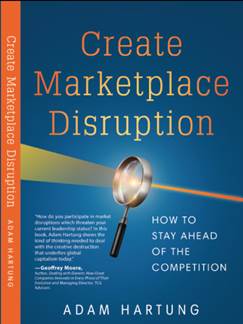The newsletters of Adam Hartung.
Keynote Speaker, Managing Partner, Author on Trends

Four Stages of Innovation Management
“Still, a man hears what he wants to hear and disregards the rest…”
Simon and Garfunkel, The Boxer
I typically add a quote toward the end of each newsletter, but this one too accurately describes the state of trend monitoring in most companies. Typically, the approach myopically expects the future too look like the past.
Caught in the Status Quo, management devotes most of its efforts to optimizing the Success Formula upon which they built the company. Lots of internal data is analyzed because it’s available and verified. Next folks look at customer data and information on won deals – which, while more variable, is verifiable. But, it’s rare, that companies routinely analyze lost sales. Isn’t it always due to “price,” or a competitor’s “new feature” your product or service doesn’t have? Perhaps some industry statistics from an association or research firm will be incorporated, but beyond that almost no external data is used to build future plans.
Trend Masters
 Perhaps the best industry at mastering the art of trend analysis is the fashion industry, because they “live” outside the company. Not only do marketers watch customers obsessively, they know howto watch and what groups to watch when gathering external information. They’ve become so good at the process that they leverage all the observations and data and actually create fashion trends every year- and the colors of the year; with names!
Perhaps the best industry at mastering the art of trend analysis is the fashion industry, because they “live” outside the company. Not only do marketers watch customers obsessively, they know howto watch and what groups to watch when gathering external information. They’ve become so good at the process that they leverage all the observations and data and actually create fashion trends every year- and the colors of the year; with names!
Your Company can Learn the Art of Trend Analysis
My last newsletter described an innovation technique designed to help you step toward greater innovation. We call it the “Ansoff L™.” By pursuing the two quadrants next to your current position, anyone can learn to innovate in a small scale. Lululemon is an example of successful growth through targeted extension into product segments customers perceive as “close” to the existing product line.

The Four Stages of Good Innovation Management
1. Market Sensing-gathering the right data for your business
Why was New Coke a spectacular failure? In part, because the researchers only gathered responses to taste. The problem was that brand preference also included habit, loyalty, etc. Sears collected data to create three levels of customer, but missed the latent need for more convenience which online shopping provided.
Look outside the company to envision trends that could impact current customers and existing product or service lines. Then put out the Google Alerts or news feeds to gather information on those trends.
2. Data Collection-gathering the right data in the right way
Sears finally put out those news feeds to gather information on customer browsing habits, but instead used intrusive tracking software that violated online privacy laws! Frito Lay researched consumer reaction to the Wow! snack products with a new ingredient, Olestra, and had a successful launch. But the product failed because researchers only tested reactions using theexpected serving size. Larger servings caused, well, intestinal distress.
Asking the right questions and monitoring the right sources are critical to reaching good conclusions.
3. Data Analysis- how to hear the right market story
“Big Data” is still a hot topic in marketing automation and analysis circles, but it hit a few bumps along the way: Pinterest accidentally congratulated single women on their upcoming weddings based spurious patterns in the data. Target found itself in a lawsuit over pregnancy coupons sent to under-age women.
Correlation is still confused with causation. Make sure you know how to interpret external data from an external viewpoint
4. Response- how to do the right thing
Many travel and hotel companies have quickly developed products for younger world-aware travelers like “eco-travel” and “BLeisure” (business and leisure). MasterCard’s “
It is not good enough to sense, accumulate and analyze data– you have to take action.
Add me to the email list!
Trends as a Competitive Advantage
Informed with the right data on trends, collected effectively, and analyzed to get a good market story, an organization can create new products and services at low risk. Learning this process is the key to the Ansoff L technique for growing in segments near your current market position. Mastering the four stages of the trend monitoring process creates a powerful sustainable competitive advantage.
How we can help
Our two decades of helping organizations identify and implement innovations gives us keen insight into how sustaining, expanding and disruptive innovations can be identified, evaluated for risk and cost, and managed for successful market growth. Our experience and processes will help you grow via innovation with more confidence, less time investment, lower cost and faster, greater returns.
For more on how to include trends in your planning, I’ve created a “how-to” that you can adapt for your team. See my Status Quo Risk Management Playbook.
Give us a call today, or send an email, so we can talk about how you can be a leader, rather than follower, in 2017 and beyond. Or check out the rest of the website to read up on what we do so we can create the right level of engagement for you.
Related Newsletters
Forbes Posts- Hartung on Leadership, Investing, Trends



